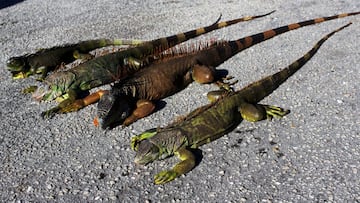Why are iguanas falling from trees in Florida according to scientists?
A new report shows that colder than average temperatures are threatening the iguana population in Florida

The National Oceanic and Atmospheric Administration (NOAA) has reported that unseasonably cold temperatures in Florida have led iguanas to begin falling from the trees. The National Weather Service Miami tweeted out an image that said "A cold morning...not as cold as our friends to the north dealing with a blizzard...but we have our own lizards to worry about."
Miami recorded temperatures as low as 24 degrees Fahrenheit, some of the lowest over the last decade.
Where are the iguanas falling from the trees?
The unseasonably fridge temperatures cause some serious trouble for the cold-blooded iguanas in South Florida because they rely on the sun and warm weather to maintain homeostasis. When this happens they can go into a coma, which may cause them to go unconscious lose their grip, and fall from their perch in a tree. While they may unable to move, it does not mean they are dead, so people should not try and touch or hold the iguanas they may encounter.
A local zoologist Stacey Cohen, who works with reptiles at Palm Beach Zoo in Florida, described the phenomenon in an interview with WPBF saying “Their bodies basically start to shut down where they lose their functions and so they are up in the trees on the branches sleeping and then because it gets so cold, they lose that ability to hang on and then they do fall out of trees a lot.”
Iguanas are very sensitive to these rapid changes in the weather because they are an invasive species that arrived in South Florida on ships from tropical countries. In their native habitat, their climate tends to stay warm year around and thus they do not face the same issues.
However, in other parts of the United States native species are under threat from climate change.
For example, last year nearly the entire juvenile population of the endangered winter-run chinook salmon were killed by record-high temperatures and drought in the Sacramento River. Less than two percent of the eggs were able to hatch and make it out of the San Joaquin Delta to the ocean. A representative from the National Marine Fisheries Service, Michael Milstein described the situation this year as “grim,” saying “The temperatures were not favorable in the river, which obviously was a result of the low water (in Lake Shasta) and the high temperatures.”
What temperatures are too cold for iguanas?
Back in 2018, when the temperature in the region began to drop, wildlife conservationists explained how cold it has to get before the iguanas are impacted. Once temperatures drop under 50 degrees Fahrenheit, iguanas can become "sluggish", said Kristen Sommers of the Florida Fish and Wildlife Conservation Commission. If drops continue under 40 degrees Fahrenheit their blood can stop pumping, which leads to them dropping from trees.
Are temperatures expected to increase?
Yes. In the coming weeks, temperatures are not expected to fall below 60 degrees Fahrenheit.






